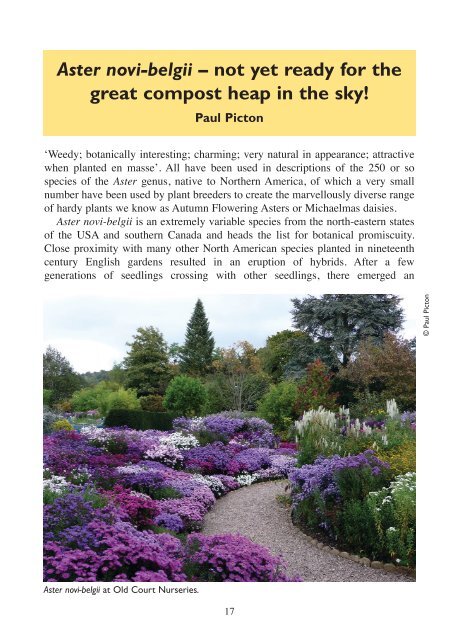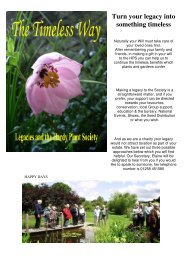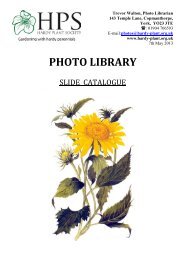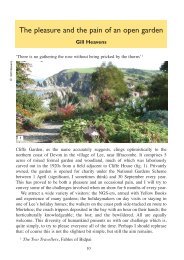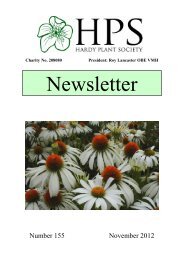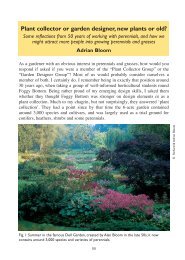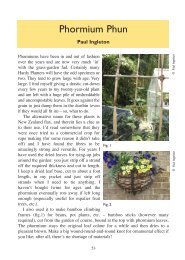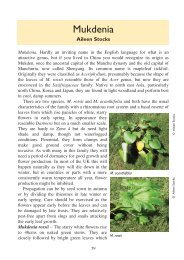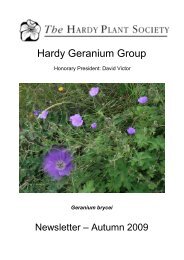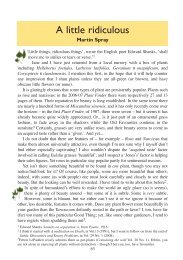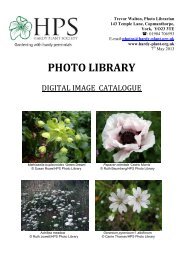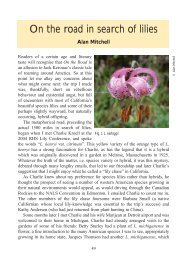Aster novi-belgii - Hardy Plant Society
Aster novi-belgii - Hardy Plant Society
Aster novi-belgii - Hardy Plant Society
You also want an ePaper? Increase the reach of your titles
YUMPU automatically turns print PDFs into web optimized ePapers that Google loves.
<strong>Aster</strong> <strong>novi</strong>-<strong>belgii</strong> – not yet ready for the<br />
great compost heap in the sky!<br />
‘Weedy; botanically interesting; charming; very natural in appearance; attractive<br />
when planted en masse’. All have been used in descriptions of the 250 or so<br />
species of the <strong>Aster</strong> genus, native to Northern America, of which a very small<br />
number have been used by plant breeders to create the marvellously diverse range<br />
of hardy plants we know as Autumn Flowering <strong>Aster</strong>s or Michaelmas daisies.<br />
<strong>Aster</strong> <strong>novi</strong>-<strong>belgii</strong> is an extremely variable species from the north-eastern states<br />
of the USA and southern Canada and heads the list for botanical promiscuity.<br />
Close proximity with many other North American species planted in nineteenth<br />
century English gardens resulted in an eruption of hybrids. After a few<br />
generations of seedlings crossing with other seedlings, there emerged an<br />
<strong>Aster</strong> <strong>novi</strong>-<strong>belgii</strong> at Old Court Nurseries.<br />
Paul Picton<br />
17<br />
© Paul Picton
© Paul Picton<br />
© Paul Picton<br />
identifiable race which bears the name of <strong>Aster</strong><br />
<strong>novi</strong>-<strong>belgii</strong> (fig. 1) to the present day. Other<br />
important contributors included AA. laevis (fig. 2),<br />
puniceus, longifolius, paniculatus, ericoides and<br />
cordifolius and the later addition by plant breeders<br />
of A. dumosus. Towards the end of the 19th century the first extensive collection of asters was<br />
growing in the famous Gibbs family garden at<br />
Aldenham, from where several of the early<br />
named varieties, including ‘Climax’, were<br />
distributed.<br />
Fig. 1 <strong>Aster</strong> <strong>novi</strong>-<strong>belgii</strong><br />
At the same time, in the Herefordshire village<br />
of Colwall, Ernest Ballard was growing drifts of<br />
Michaelmas daisies in his garden. Although very<br />
much an admirer of the graceful species and the<br />
gentle colours of the flowers adorning arching, tall<br />
stems, he saw an opportunity to improve the floral<br />
qualities of the existing hybrids. He sought to<br />
breed sturdier flowering sprays bearing larger<br />
numbers of blooms from plants with roots which<br />
did not invade the whole border within a season<br />
of growth. Ballard also considered it was<br />
Fig. 2 A. laevis<br />
important for his plants to be useful as cut<br />
flowers. In 1906 he established Old Court<br />
Nurseries as trial grounds for his “new race of asters” and these quintessentially<br />
English hardy perennials are still flourishing on the same site as the mainstay of<br />
the <strong>Plant</strong> Heritage National Collection of Autumn Flowering <strong>Aster</strong>s, in the<br />
Picton Garden at Old Court Nursery at Colwall, near Malvern.<br />
In the early years of his breeding programme, Ernest Ballard painstakingly<br />
created deliberate crosses between selected seedlings to try to achieve the results<br />
he had in mind. However, he soon found greater success in the careful selection<br />
of large quantities of seedlings from parent ‘selfed’ plants which showed a step<br />
towards a desired colour, size of bloom, or shape of flowering spray. At the height<br />
of his work in the 1920s and 1930s, up to 5 acres of land was devoted to first-year<br />
seedlings and older plants grown on to test their garden qualities. Many other<br />
nurserymen saw the potential and reaped the benefits of the rise to universal<br />
popularity of Michaelmas daisies. However, it was always Ballard who led the<br />
way with new varieties, fully recognising the commercial importance of being<br />
ahead with his breeding.<br />
More than 60 good cultivars originated in Colwall: the lovely ‘Marie Ballard’<br />
18
(fig. 3) was selected just before his death in<br />
1952, but was not sold until 1955 when<br />
sufficient stocks were available. It’s<br />
interesting to look back at some of the<br />
earlier named varieties which led to the<br />
clean, lavender-blue rays in its superbly<br />
formal flowers. ‘Climax’ has precisely<br />
circular, lavender-blue flowers on tall<br />
sprays and shows much affinity with A.<br />
laevis in its broad foliage and stout basal<br />
shoots. ‘Beauty of Colwall’ (fig. 4) is an<br />
early example of Ballard’s move towards<br />
flowers with a larger ray count. In the 1920s<br />
‘Anita Ballard’ (fig. 5) introduced cleaner<br />
shades of lavender blue in the rays. Through the 1930s cultivars including<br />
‘Princess Marie Louise’ and ‘The Sexton’ (fig. 6) brought larger flowers. In the<br />
1940s ‘Plenty’ showed a great improvement in both the colour and size of the<br />
flowers, in addition to having very substantial, weatherproof rays. In the early<br />
1950s more rays increased the double effect of the flower with ‘Ada Ballard’ (fig. 7),<br />
though the shade of colour was sacrificed to a lilac blue. Seed, saved from<br />
‘Ada Ballard’ some years before it was released for sale, produced the plant later<br />
to become ‘Marie Ballard’.<br />
Here was the most pure<br />
blue aster to date with<br />
full, double flowers as a<br />
bonus. Stems are sturdy to<br />
1m high and the compact<br />
root clumps produce large<br />
numbers of shoots. ‘Marie<br />
Ballard’ must have been<br />
frequently renamed by other<br />
growers, for when we were<br />
building our collection in<br />
the 1980s, no less than 12<br />
different ‘names’ from<br />
various sources all proved<br />
to be her!<br />
The nurseries of Jones<br />
and the well-known Perry’s<br />
of Enfield were notable<br />
Fig. 4 ‘Beauty of Colwall’<br />
19<br />
Fig. 3 ‘Marie Ballard’<br />
© Paul Picton<br />
© Paul Picton<br />
Fig. 5 ‘Anita Ballard’<br />
Fig. 6 ‘The Sexton’ Fig. 7 ‘Ada Ballard’<br />
© Paul Picton<br />
© Paul Picton<br />
© Paul Picton
© Paul Picton<br />
growers of asters from Edwardian times. In the<br />
1930s Woods nurseries introduced the<br />
Beechwood range, the origin of most cultivars<br />
with purple-red flowers. In 1950 Ernest Ballard’s<br />
introduction of ‘Red Sunset’ was a huge success.<br />
Percy Picton followed up with ‘Rufus’(fig. 8) in<br />
1956, ‘Freda Ballard’ in 1959, then in 1962<br />
‘Helen Ballard’, the best of the purple-red shades.<br />
In addition to Ballard (who was succeeded at<br />
Old Court Nurseries by my father, Percy Picton)<br />
other notable growers and breeders of asters<br />
through the middle years of the 20th Fig. 8 ‘Rufus’<br />
century were<br />
Carlile’s of Twyford, Gayborder Nurseries from Melbourne in Derbyshire,<br />
Sandford’s in East Anglia and Baker’s of Codsall. Carlile’s introduced<br />
‘Fellowship’ (fig. 9) which probably has the largest flowers of any modern aster<br />
in the <strong>novi</strong>-<strong>belgii</strong> group – the pale pink blossoms cover generous, shapely sprays.<br />
Interestingly, the plant was raised by Sandford’s, which is still remembered by the<br />
free-flowering ‘Sandford’s White Swan’ (fig. 10). ‘Percy Thrower’ is another<br />
variety with spectacular, large flowers, this time with rich, lavender-blue rays. It<br />
was raised in 1958 during Mr. R. Lidsey’s time at Gayborder Nurseries. In the<br />
early 1960s, Mr. T. Mills was in charge of the asters at Bakers and he introduced<br />
many of the excellent varieties, raised by Ronald Watts, such as heather-purple<br />
‘Coombe Rosemary’ (fig. 11) and purple-red ‘Janet Watts’.<br />
George Chiswell was born in Colwall and his first job was working in the<br />
gardens at Old Colwall House for Mrs. Raynor-Wood. After the Second World<br />
War he moved to Midsomer Norton near Bath and by the 1960s was running his<br />
own nursery, growing a wide range of plants. He must have loved the memory of<br />
Ernest Ballard’s fields of asters dotted around his birthplace because he raised<br />
many new varieties based on the best from Old Court Nurseries. A number of<br />
them are named after Somerset mining villages, such as the rich, purple-blueflowered<br />
‘Gurney Slade’ (fig. 12) and the soft pink ‘Timsbury’. ‘Priory Blush’<br />
was named after his Priory Nursery. It has graceful sprays of white flowers,<br />
flushed with pink, and is an excellent variety for cutting.<br />
All of the cultivars mentioned so far grow 100–150cm tall. Dwarf cultivars of<br />
A. <strong>novi</strong>-<strong>belgii</strong> did not exist when Old Court Nurseries began, and even when the<br />
work of Victor Vokes and others resulted in compact varieties for the front edges<br />
of borders, Ballard usually dismissed them as being formless clumps. He must<br />
have relented on occasion because ‘Snowsprite’, ‘Little Pink Lady’ and<br />
‘Rosebud’ are among the varieties he raised. ‘Rosebud’ is unique in having small,<br />
tightly double flowers of light pink and is just 30cm tall. It was only after the war<br />
20
that the public showed much interest in shortgrowing<br />
asters. ‘Lady in Blue’ (fig. 13) was raised by<br />
Perry’s and introduced by Carlile’s in 1955. In the<br />
1960s the ever popular and showy, pale pink<br />
‘Chatterbox’ (fig. 14) was introduced by Bakers, and<br />
from Blooms Nurseries came sturdy 40cm ‘Jenny’<br />
with large purple-red flowers and its twin, ‘Royal<br />
Ruby’. Records indicate ‘Jenny’ as a different plant<br />
raised by Mr. Harrison in 1926. In spite of the<br />
confusion, the modern ‘Jenny’ became one of the<br />
best-selling asters of all time. Dutch and German<br />
plant breeders came to the fore with many excellent<br />
dwarf cultivars: ‘Professor Anton Kippenberg’ has<br />
bright blue flowers, ‘Kassel’ bright, reddish-purple<br />
and ‘Rosenwichel’ pink flowers on low spreading<br />
clumps.<br />
Few <strong>novi</strong>-<strong>belgii</strong> asters from the 1920s and 1930s<br />
grow to the useful height of around 60cm. The dwarf<br />
cultivars led slowly to the introduction of a small<br />
range of these intermediate-sized plants. William<br />
Woods and Sons of Taplow offered ‘Little Red Boy’<br />
in 1946. It was bettered in 1950 by the Gayborder<br />
Nurseries introduction of ‘Winston S. Churchill’, a<br />
very bushy plant, about 70cm, with masses of bright,<br />
purple-red flowers, an instant hit with gardeners, in<br />
spite of being more prone to mildew attack than most.<br />
‘Chequers’ (fig. 15) was raised by Gayborder Nurseries<br />
in 1953 and has really rich, violet-purple flowers.<br />
Percy Picton raised the very last ‘Ballard’ aster,<br />
from the original strain, in 1972. This was ‘Sarah<br />
Ballard’, named after Ernest Ballard’s granddaughter.<br />
The flowers are large, full rayed, lilac purple, on plants<br />
growing to about 100cm. So far the only <strong>novi</strong>-<strong>belgii</strong><br />
asters I have seen fit to add were ‘Ralph Picton’<br />
(fig. 16) in 1991 and in 1994 ‘Marjory Ballard’, named<br />
after a Colwall lady who was a very keen gardener and<br />
the wife of one of Ernest Ballard’s nephews.<br />
The popularity of the <strong>novi</strong>-<strong>belgii</strong> group spanned 70<br />
years. Before the war, borders devoted to them were<br />
a common feature in gardens throughout the UK. It<br />
21<br />
Fig. 9 ‘Fellowship’<br />
Fig. 10 ‘Sandford’s White Swan’<br />
Fig. 11 ‘Coombe Rosemary’<br />
Fig. 12 ‘Gurney Slade’<br />
© Paul Picton<br />
© Paul Picton<br />
© Paul Picton<br />
© Paul Picton
© Paul Picton<br />
© Paul Picton<br />
© Paul Picton<br />
© Paul Picton<br />
Fig. 13 ‘Lady in Blue’<br />
Fig. 14 ‘Chatterbox’<br />
Fig. 15 ‘Chequers’<br />
Fig. 16 ‘Ralph Picton’<br />
was quite usual for these borders to be replanted each<br />
year with young stock produced from offsets, cuttings<br />
or division, the best displays coming from potted<br />
offsets, planted out in groups. The taller varieties<br />
required support from an early stage of growth and<br />
careful tying in throughout the growing season. The<br />
labour involved in such intensive growing was readily<br />
available in the days when it was possible to employ<br />
several gardeners. Regular spraying would be<br />
undertaken in the hope of curing mildew or preventing<br />
it from disfiguring the foliage. Although the range of<br />
sprays available to modern gardeners has been limited<br />
by largely unnecessary regulations, the ones we have<br />
left are effective preventatives when used properly.<br />
Many 21 st century gardens lack enough space for an<br />
aster border (or any border devoted to one genus). But a<br />
careful selection of cultivars will come up with plenty<br />
to fit into all sorts of mixed planting schemes. This<br />
same selection will give a good show of flowers from<br />
clumps divided every third year. In addition there are<br />
numerous traditional varieties to grow specifically for<br />
cut flowers, and others well suited for colourful<br />
displays in autumn containers. None will require a<br />
polytunnel or chemicals to keep its height down!<br />
A loyal band of gardeners still plant cultivars of A.<br />
<strong>novi</strong>-<strong>belgii</strong>, somewhat in defiance of the current trend to<br />
make use of the increasing range of less troublesome<br />
cultivars of A. novae-angliae and the ever popular A. x<br />
frikartii ‘Mönch’ and several good varieties of A.<br />
amellus.<br />
Many <strong>novi</strong>-<strong>belgii</strong> have been hybridised with smallflowered<br />
varieties, such as A. pringlei ‘Monte Cassino’,<br />
to produce a modern range of plants for the worldwide<br />
cut-flower industry. They are mostly not intended for<br />
garden planting, even if available for the purpose. This<br />
said, some of these hybrids have been successfully<br />
selected to provide plants for naturalistic and prairie<br />
planting schemes. Piet Oudolf is internationally<br />
renowned for his work in this style of using herbaceous<br />
perennials and A. ‘Ochtendgloren’ is one of his early<br />
22
introductions. A. <strong>novi</strong>-<strong>belgii</strong> cultivars have<br />
also been used in the breeding of ‘dwarfed’<br />
pot-grown asters, which are definitely not<br />
suitable for traditional garden use.<br />
A current and promising trend in the<br />
breeding of asters for the garden involves<br />
A. <strong>novi</strong>-<strong>belgii</strong> and A. cordifolius. Developments<br />
have been inspired by Mrs.<br />
Thornely’s 1930s introduction of A.<br />
‘Little Carlow’ (fig. 17), a wonderful plant<br />
combining the best characters from both<br />
parents: stout, long-lived clumps of<br />
graceful 120cm sprays of bright, lavenderblue<br />
flowers over a long season. A. laevis<br />
and A. x salignus are also being involved. It<br />
seems that, far from being consigned to the<br />
great compost heap of worthless plants, the<br />
Fig. 17 ‘Little Carlow’<br />
wonderful floral qualities of A. <strong>novi</strong>-<strong>belgii</strong> cultivars will still have an important<br />
role to play in the future of Autumn Flowering <strong>Aster</strong>s.<br />
Paul Picton literally grew up among fields of Michaelmas daisies, living the yearround<br />
routine of growing the plants commercially – his father, Percy, went to<br />
Colwall to manage Old Court Nurseries for Ernest Ballard when Paul was just<br />
six. Percy Picton acquired the nursery business in 1956, and Paul joined him,<br />
later assuming control of the business in the 1970s – at the depths of the<br />
depressing period when few people wanted to buy these asters.<br />
It was in the late 1980s when Paul’s wife Meriel told him that the time had come<br />
to revive an interest in asters. So,The Picton Garden expanded on the old aster<br />
trial grounds, and asters old and new poured in from all the remaining sources.<br />
Isabel Allen and Joy Huish were the main contributors because they wished to<br />
pass on their existing collection to ensure the future of the plants. The new<br />
collection was registered in the early years of the then NCCPG. Large, colourful<br />
borders in the old pre-war style attracted crowds of visitors and many gardening<br />
photographers. A new era for Michaelmas daisies was launched.<br />
Paul and Meriel’s daughter, Helen, took a degree in botany and has now joined<br />
them at Old Court Nurseries (see p9)– the third generation of the Picton family<br />
to be involved in growing Autumn Flowering <strong>Aster</strong>s.<br />
For more photographs and information see www.autumnasters.co.uk<br />
23<br />
© Paul Picton
© Paul Picton<br />
Choosing a Michaelmas daisy – Paul recommends…<br />
‘Marie Ballard’ (fig. 3) – best shade of blue flowers. <strong>Plant</strong>s live for several years<br />
without division, unless you crave the finest quality sprays. Sept. & Oct.<br />
‘Harrison’s Blue’ – rich violet blue, flowering quality good for three seasons. Oct.<br />
‘Priory Blush’ (fig. 18) – white with pale pink – unusual soft colours and graceful<br />
sprays ideal for flower arranging. Three years before needing division. Sept. – Oct.<br />
‘Helen Ballard’ (fig. 19) – the best-formed and the brightest purple-red flowers.<br />
Divide annually for stronger growth and flowering stems. Late Sept.<br />
‘Mary Deane’ – vibrant purple pink (all the rage in the 1960s), a strong-growing<br />
cultivar brings a long lasting splash of colour to autumn borders. Quite satisfactory<br />
if undivided for several years. Sept. & Oct.<br />
‘Rosebud’ – a rather curious, ultra-compact-growing variety rarely reaching 30cm<br />
tall. Grown well, it puts on a superb display of small, fully double, button-type<br />
flowers on stiff sprays. Lovely for small flower arrangements. Best results from<br />
plants divided each spring. Sept. & Oct.<br />
‘Lisa Dawn’ – everyone looking for a red, dwarf-growing aster wants ‘Jenny’; but I<br />
prefer the early-flowering ‘Lisa Dawn’ – 40cm tall mulberry-red flowers. Can be<br />
left in site for three years. From late Aug.<br />
‘Remembrance’ – no one should miss out on this compact, 45cm cultivar, with<br />
large, lavender-blue flowers. Can be OK for five years but three is quite long<br />
enough. Oct.<br />
All cultivars of <strong>Aster</strong> <strong>novi</strong>-<strong>belgii</strong> need an open, sunny site in fertile soil which<br />
retains moisture in the summer months. The dreaded curse of mildew is best<br />
avoided by biting the ‘green’ bullet and using a suitable preventative spray at<br />
regular intervals between late spring and flowering time. The old fashioned method<br />
of dividing the plants into individual offsets each spring and giving them plenty of<br />
space for air circulation might be helpful. Chelsea chopping is said to reduce<br />
mildew, but it may not work very well in long, dreary, cloudy summers which slow<br />
down the rate of regrowth and lead to indifferent results at flowering time.<br />
Fig. 18 ‘Priory Blush’<br />
© Paul Picton<br />
Fig. 19 ‘Helen Ballard‘<br />
24


